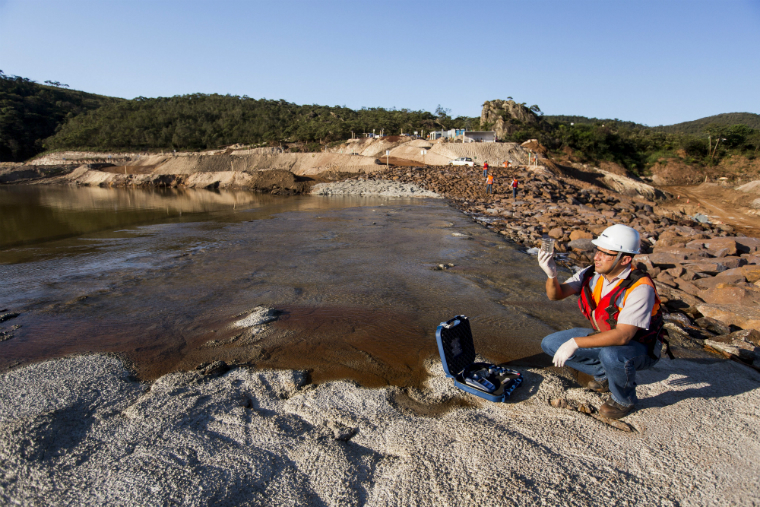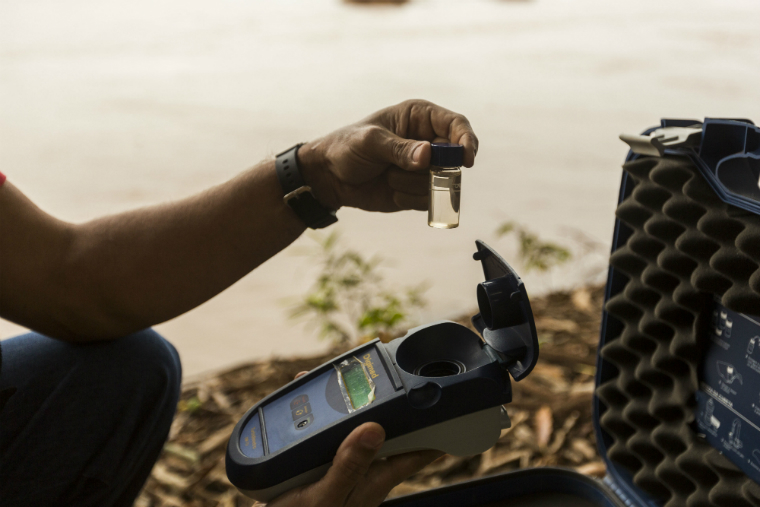In total, 115 points along the river, tributaries, river mouth and sea water are being analyzed
The results of the Doce River water quality monitoring already present improvements. Currently, 115 points are monitored manually by the team of the Renova Foundation in partnership with environmental agencies. The turbidity parameter is daily monitored at 77 points.
The main objective of this action is to develop and implement the Quali-Quantitative Systematic Monitoring Program (PMQQS) for the Doce River Basin, Estuarine, Coastal and Marine Areas that were impacted, for the analysis of water and sediment, permanently, also covering the evaluation of toxicological and ecotoxicological risks, according to requirements of the Technical Board for Water Security and Water Quality.
Some improvements in water quality have been observed by the monitoring work. In February 2017, the Ribeirão do Carmo monitoring point in Barra Longa (MG) for example, near the confluence with the Piranga River, reached turbidity below 100 NTU, value set by Resolution 357/2005 for Fresh Water, Class 2, established by the National Council of the Environment (Conama). The index reflects the tailings containment works and environmental restoration performed by Renova, and is an indication that less and less sediments are reaching the reservoirs of the region.

Currently, the water quality in 115 points of the river Doce, tributaries and marine water is monitored. | Photo: Leo Drumond / NITRO
All analyses are performed based on the compliance parameters set by the Conama resolution, such as turbidity, total suspended solids, dissolved and total aluminum, iron and manganese, which are regarded as relevant parameters, i.e. those previously identified as influenced by the Fundão dam collapse. The results are sent and analyzed by the Brazilian Institute of Environment and Renewable Natural Resources (Ibama) and the State Institute for the Environment and Water Resources of Espírito Santo (Iema).
According to the Doce River Monitoring Report of February 2017, concentrations of aluminum, iron, manganese, turbidity, true color and other parameters which are more strongly influenced by the collapse were significantly higher in the period from November 6 to December 31, 2015 – period close to the dam collapse and coinciding with the rainy season – than in later periods and closer to the dam than those in more distant areas.
The results of the Doce River water quality tests performed by the Renova Foundation have shown water quality standards consistent with the monitoring carried out by the Water Management Institute of Minas Gerais (Igam) and by Iema.
HOW IT WORKS:
According to Birgitta Maioli, environmental engineer and expert of the monitoring program of the Renova Foundation, the collection points that require greater attention are those located between the Candonga (MG) mine and the dam (MG), regions most affected by the tailings, and in the municipalities where there is water withdrawal from the Doce river and its tributaries.
The water quality monitoring takes place as follows:
- Definition of monitoring points
- Collection at predetermined points
- Biweekly or daily lab analysis of water from 77 points
- Issuance of laboratory reports
- Consolidation and analysis of the results by specialized consulting agency
- Forwarding of the results and consolidated analysis for the environmental agencies
In addition to the monitoring performed by the Renova Foundation, environmental agencies also perform independent monitoring along the Doce River. Residents of the affected regions and others who wish to stay informed about the water quality of the Doce River can check the results of the Monitoring of the Doce River Surface Water Quality in the State of Minas Gerais, performed by Igam and Iema. The Renova Foundation contributes to the publication providing the agency with information on the results of its monitoring points.

The results of monitoring the water quality of the Doce river are already improving. | Photo: Leo Drumond / NITRO
FUTURE CHALLENGES AND EXPECTATIONS
Despite the progress, there is still much to be done through the Doce River Monitoring Program. From now on, the actions will undergo a transition from emergency monitoring, based on notifications of environmental agencies, to the implementation of the Permanent Quanti-Qualitative Monitoring Plan.
The Plan was submitted to the Inter-Federative Committee (CIF) and should be implemented by July 31, 2017. The document is provided for in the Transaction and Conduct Adjustment Term (TTAC), which defines all phases necessary for laboratory analysis and creates an automatic monitoring network of field parameters.
This strategy is important because the devices will generate data on rainfall, air temperature and river water level. Furthermore, the results will be transmitted online to form an information and alarm network for the Command Centers and Water Supply Companies.
Eight of these stations will be equipped with a probe that hourly measures multiple parameters such as turbidity, acidity (pH), conductivity and water temperature, as well as the existence of microorganisms. This information will support the operational planning of the Water Treatment Plants.
The implementation of the automatic monitoring networks has already begun. On March 8, the civil bases of the first station were completed which will be operational upstream of the Candonga Plant.
RAINY SEASON
The Renova Foundation developed an action plan for the rainy season that consists of preventive and contingency measures to minimize the impacts on society, the environment and the economic activities of the locations impacted by the collapse of the Fundão dam.
One of the main actions was the implementation of flood alerts, in order to facilitate decision-making in cases of increased river levels. The system is already in operation in the Carmo River Basin in the region of Mariana and Barra Longa (MG).
The system consists of three phases: data collection (automatic devices, real-time monitoring of rainfall, flow and levels), data processing (analysis and consistency of information, hydraulic calculations and modeling and prediction of flow rates) and data transmission (communication to responsible teams).
Additionally, during the rainy season there are also weekly analyses of the potability of the water treated in 13 Water Treatment Plants (ETA) that withdraw their water from the Doce River and provide for the population in, for example, the municipalities of Governador Valadares -MG and Colatina-ES.
The analyses are based on the compliance parameters set by Potability Decree 2914/11 of the Ministry of Health, such as turbidity and metals, as well as the absence of microorganisms. The results are personally validated by a water resources expert to verify if the treated water is suitable for consumption by the population to be served. The potability tests are also carried out by the responsible parties of the Water Supply Systems of these municipalities.
